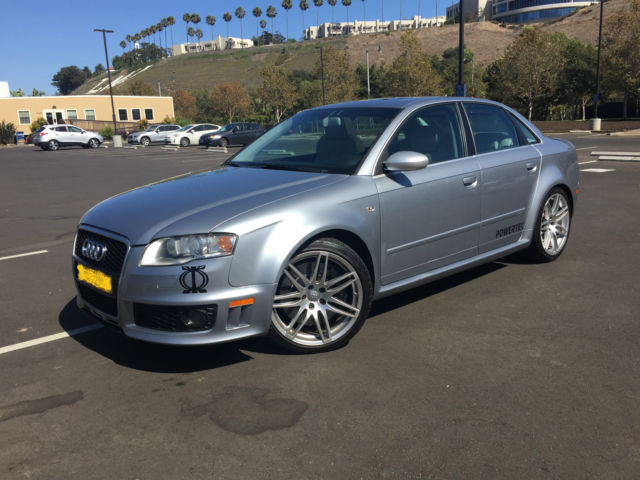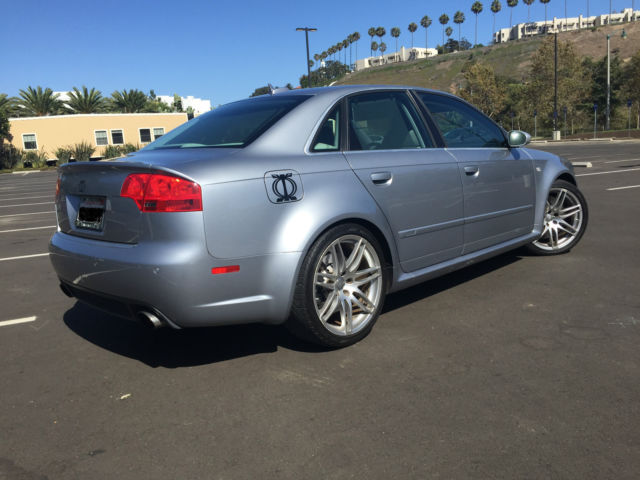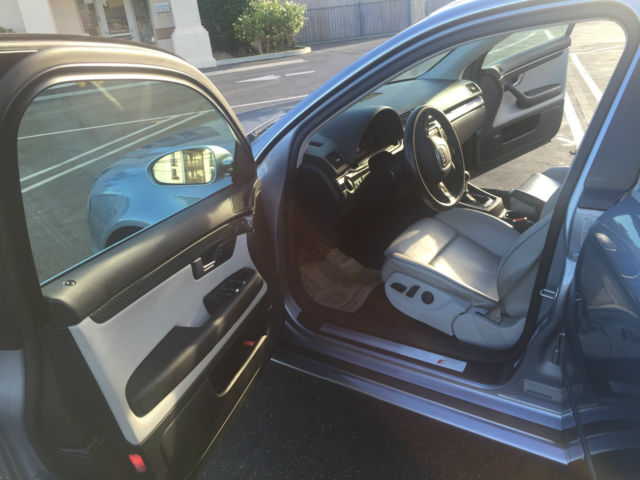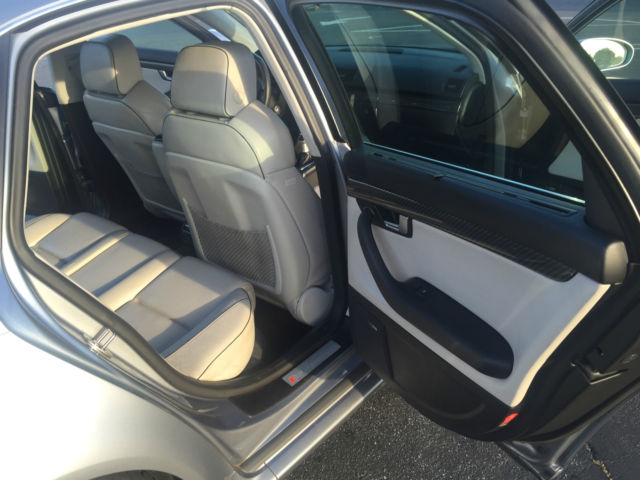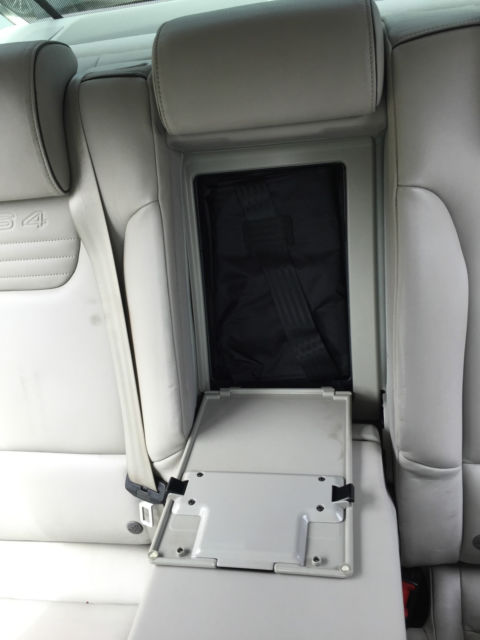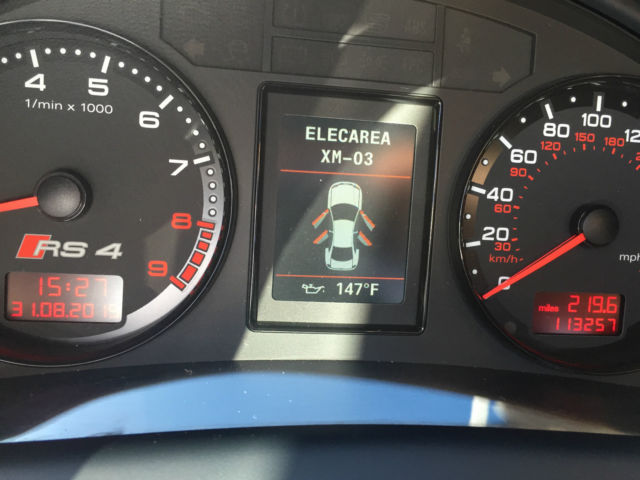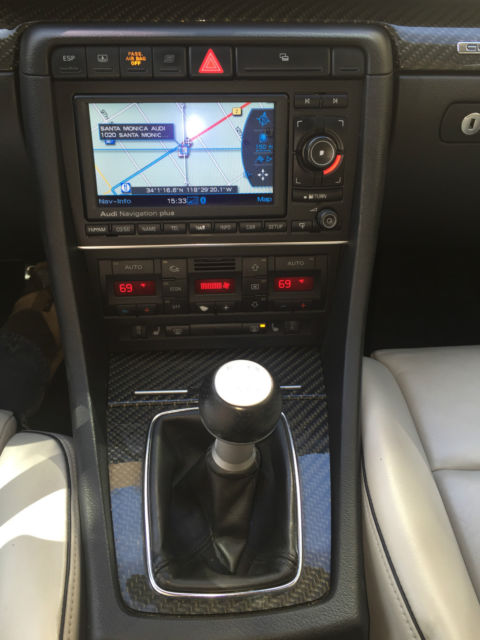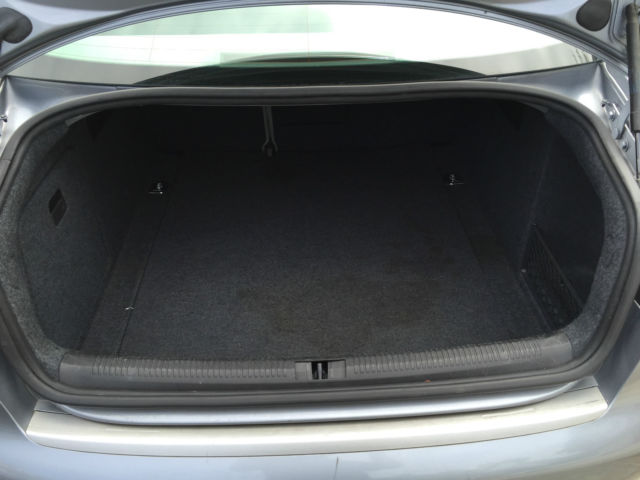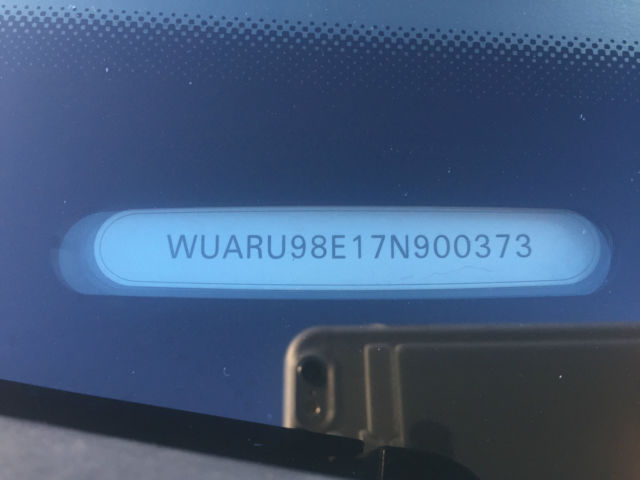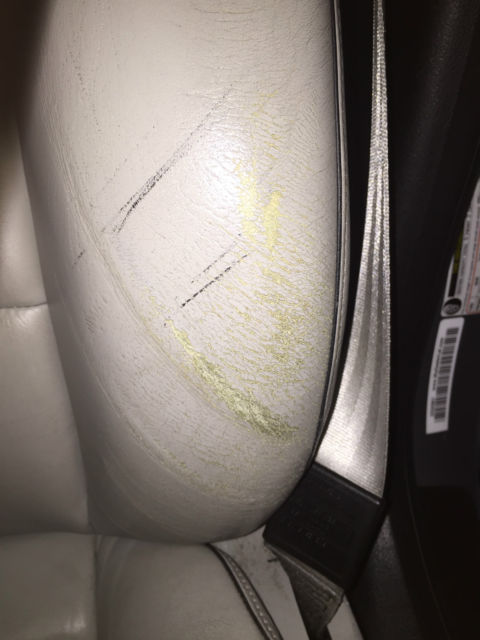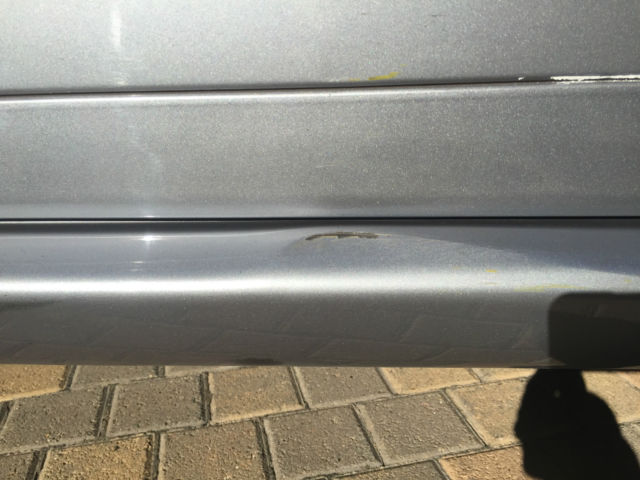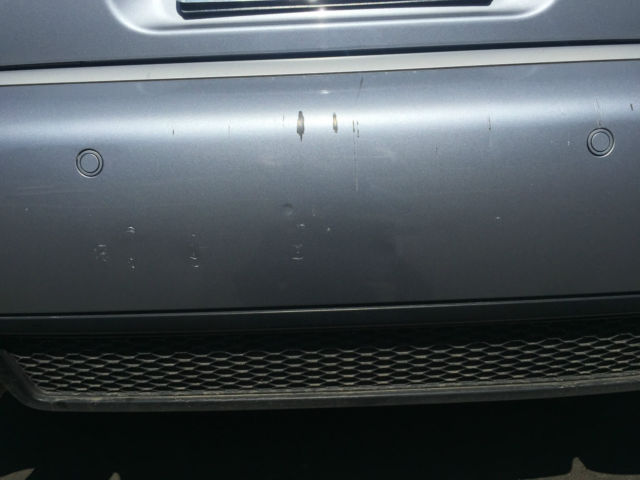!NO RESERVE! 2007 Audi RS4 Sedan Avus Silver on Silver Interior Fully Loaded
- Condition: Used
- Make: Audi
- Model: RS4
- SubModel: 2007-a
- Type: Sedan
- Trim: Base Sedan 4-Door
- Year: 2007
- Mileage: 117,123
- VIN: WUARU98E17N900373
- Color: Silver
- Engine size: 4.2L 4163CC V8 GAS DOHC Naturally Aspirated
- Number of cylinders: 8
- Power options: Air Conditioning, Cruise Control, Power Locks, Power Windows, Power Seats
- Fuel: Gasoline
- Transmission: Manual
- Drive type: AWD
- Interior color: Gray
- Safety options: Rear Side Airbags, Anti-Lock Brakes, Driver Airbag, Passenger Airbag, Side Airbags
- Options: XM Satellite Radio, CD Changer, 4-Wheel Drive, CD Player, Leather Seats, Sunroof
- Vehicle Title: Clear
- Interested?
2007 Audi RS4 2007-a Description
!NO RESERVE!Daily driver, so miles are still increasing.
Options include XM Radio w/ glove box CD Changer & Rear Seat Airbags.
Rear Bumper Scratches, Driver Side Running Board Scratches & Driver Seat Wear; Normal curb rashes on Rims. Car is completely original w/ no after market parts or modifications. Serviced thru Audi only, so all service records in the Audi Database. I'm original owner & had the car Certified once original factory warranty ended; I also bought an extended warranty that ended in 2014 w/ ~105K miles.
Truly a unique vehicle in California. Only 10K units were produced w/ only 2,500 units in the US; Stahmann registry of 1,953 vehicles only show my unit in California in my color combination & options & only 2 in the registry itself!...that is less than a tenth of a percent of RS4's listed. Avus Silver w/ Silver interior is only 2% of the registered units in the Directory.
The Audi RS4 quattro is the top tier & highest performing version of some specific generations of the Audi A4 range of automobiles. It is a sports-focused compact executive car produced by Audi's high-performance private subsidiary quattro GmbH, in limited numbers, for German car manufacturer AUDI AG, part of the larger Volkswagen Group. It slots distinctly above the Audi S4, as the fastest, most sports-focused model based on the A4's "B" automobile platform.
The "RS" initials are taken from the German: RennSport—literally translated as "racing sport" & is the Audi marque's highest trim level, positioned above the "S" model specification of Audi's regular model line-up. Like all Audi "RS" cars, the RS4 pioneers some of Audi's latest advanced technology, & could therefore be described as a "halo vehicle". Furthermore, it is only available with Audi's Torsen-based "TM" quattro permanent 4-wheel drive system.
Audi RS4 quattro (B7) Overview
Production2006–2008
Body & Chassis
Body style4-door saloon/sedan
PowertrainEngine4.2 L V8 FSI 2 × DOHCTransmission6-speed Getrag manual
DimensionsWheelbase2,648 mm (104.3 in)Length4,589 mm (180.7 in)Width1,816 mm (71.5 in)Height1,415 mm (55.7 in)Kerb weight1,650–1,680 kg (3,638–3,704 lb)
There was no RS4 built on the Audi "B6" platform that served as the basis for the Audi A4 between 2001 & 2005. However, after a long hiatus, the second Audi RS4 quattro (Type 8E), was built on Audi's "B7" A4 platform, by quattro GmbH in Neckarsulm, Germany. It was unveiled in February 2005 at Audi's 'quattro Night' celebration at the company headquarters in Ingolstadt, Germany.
It was introduced at the 2006 North American International Auto Show in January & arrived in June 2006 in North America. The production run of the B7 RS4 was 2006 to 2008 inclusive, although only 2007 & 2008 model year were sold in the United States. To date, approximately 10,000 B7 RS4s have been built, of which around 2,500 are in the USA.
Audi factory numbers indicate that the B7 RS4 saloon can accelerate from 0 to 100 kilometres / hour (0.0 to 62.1 mph) in 4.8 seconds & arrive at 0 to 200 kilometres / hour (0.0 to 124.3 mph) in 16.6 seconds. Most European magazines recorded results in line with the November 2009 comparison of "ultimate sedans" in Road & Track which recorded a 0 to 60 time of 4.5 seconds. This is consistent with the pattern of conservatism that is usually found in Audi's official performance numbers. Top speed for all variants is "officially" electronically limited to 250 kilometres / hour (155.3 mph), though some owners have reported that the speed limiter is rather "liberal", conforming to the pattern of previous Audi "RS" cars, with genuine top speeds of 270 kilometres / hour (170 mph) being recorded.
B7 bodywork & styling
Like its B5 predecessor, visually, the B7 RS4 differs from its related B7 S4, by having even wider flared front & rear wheel arches (fenders) to allow for a wider axle track. Over the B7 A4, it also includes 2 larger frontal side air intakes (for the 2 additional side-mounted coolant radiators). The trim on the saloon & roof rails on the estate are chrome as standard. The B7 RS4 also includes an optional adaptive headlights to complement the standard "Xenon Plus" (Bi-Xenon) High Intensity Discharge (HID) headlamps, which swivel around corners in conjunction with steering wheel movements. Also standard are daytime running lights (DRLs) found within the main headlamp housings, identical to its related B7 A4 & S4, & use a conventional tungsten filament bulb. An acoustic parking system with rear sensors is also a standard fitment. Unique carbon fibre interior trims, along with a lap timer within the central Driver Information System (DIS), aluminium pedal caps & footrest, & RS4 logos, complete the look.
In the saloon, luggage space, measured according to the VDA 'block method', is 460 litres (16.2 cu ft) with the rear seats in the upright position, & 720 to 833 litres (25.4 to 29.4 cu ft) with the seats folded flat (dependent on specification). Kerb weight of the saloon variant starts at 1,650 kilograms (3,638 lb) (dependent on specification).
Navigation option is the RNS-E "Audi Navigation System plus" DVD-ROM GPS satellite navigation, which includes a folding widescreen 6.5-inch screen, 2 SD-memory card readers, & MMI-like logic control.
B7 interior safety
To achieve maximum body stiffness with controlled deformation crumple zones, the B7 RS4 features laser beam welding of major seams of the high-strength steel body shell, which helps improve overall structural rigidity, particularly in the "passenger cell", over traditional spot welding methods.
2-stage driver & front seat passenger frontal airbags are standard, as is Audi's "sideguard" head protection curtain airbag system. This latter system completely covers all of the side windows, from the front 'A pillar' to the rear "C-" or "D pillars". In North America, the only front seats available are the more traditional Recaro seats (identical to those in the B6 & B7 S4), which include lower side airbags; these were also available as a no-cost option in other markets. Lower side airbags are optional for the standard-fit Recaro rear seats. Front, & outer rear seatbelts include pyrotechnic belt pretensioners, whilst all belts include an excess load limit function.
B7 powertrain
The engine of the B7 RS4 is based on the existing all-alloy 4.2 V8 from the B6 S4 & shares many parts & Fuel Stratified Injection with the 4.2 FSI V8 engine in the Q7. The engine includes new cylinder block construction & is a highly reworked, high-revving variant (redline at 8,000 rpm; rev limit of 8,250 rpm). The parts code & version is 079.D & the identification code is BNS.
The engine has increased crankcase breathing, a low-pressure fuel return system & a baffled oil sump, to prevent engine lubricant cavitation at high engine speeds & high-G cornering. It has 4 valves / cylinder (instead of 5 on the earlier variant) & 2 overhead camshafts on each cylinder bank (so it is 'quad cam') & these are driven by roller chains with variable valve timing for both inlet & exhaust camshafts, along with a cast magnesium alloy fixed tract length intake manifold with adjustable tumble flaps (to improve low engine speed combustion). On 98 RON (93 AKI) Super-Unleaded petrol it produces 309 kilowatts (420 PS; 414 bhp) at 7,800 rpm giving it a specific power output of 74.2 kW (100.9 PS; 99.5 bhp) / litre. Based on a kerb weight of 1,680 kilograms (3,704 lb), this results in a power-to-weight ratio of 184 watts / kilogram. This engine also produces 430 newton metres (317 lbf·ft) of torque at 5,500 rpm, 90 percent of the total torque being available between 2,250 & 7,600 rpm. (Using lower 95 RON (91 AKI) standard unleaded fuel slightly reduces engine output, & therefore performance & slightly worsens fuel economy). Exhaust gas escapes through 2 '4-into-2-into-1' fan-branch alloy steel exhaust manifolds & 4 high-flow metallic sports catalytic converters, into twin oval tail pipes with integral dynamic silencer/muffler valves. The engine is controlled by 2 Bosch DI-Motronic MED 9.1 electronic engine control units (working as 'master' & 'slave', because of the high-revving nature of the engine), & uses Bosch 'E-Gas' electronic throttle control (also known as drive by wire), comprising throttle device, accelerator-pedal module, & ECU. The ignition system uses 8 individual single-spark coils, using mapped direct ignition, with Bosch single iridium electrode or NGK triple-electrode long-life spark plugs. Ignition timing is monitored with the aid of 4 knock sensors. The engine complies with the Euro4 European emission standards. The saloon version produces 322-329 grams of CO2 / kilometre (g/km), & the Avant starts from 324 g/km.A 6-speed Getrag manual gearbox (parts code: 0A3, identification codes: HLD, JHM) is the only transmission available. The gear ratios are 1st: 3.667, 2nd: 2.211, 3rd: 1.520, 4th: 1.133, 5th: 0.919, 6th: 0.778.
quattro
Another focus of the B7 RS4 was on the introduction of the latest development of Audi's 'TM' quattro permanent 4-wheel drive system. This utilised the 'third generation' asymmetric/dynamic Torsen T-3 'automatic torque biasing' (ATB) centre differential featuring a 'default' 40:60 front-to-rear torque split under normal conditions. Audi stressed that this would result in a more neutral response in corners & a more dynamic driving experience. Also, a more aggressive Torque Bias Ratio (TBR) was used & set to 4:1, as opposed to 2:1 (& later variants 3:1 TBR) on standard A4. That means that 1 side of the differential can handle up to 80% while the other side would have to only handle 20% of applied torque.
Front & rear axle differentials are conventional "open" types with a final drive ratio of 4.111.
Traction is assisted by way of Audi's "Electronic Differential Lock" (EDL), which is a specific function of the Robert Bosch GmbH ESP 8.0 Electronic Stability Programme system. EDL monitors the rotational speeds of the left & right wheels across an individual axle, & if 1 wheel should rotate faster than the other (exceeding the pre-defined parameters), indicating loss of traction, or "wheel spin" on 1 wheel, the EDL applies the brakes to that individual spinning wheel & thus results in transferring torque across the open differential to the wheel on the other side deemed to have grip, hence traction. Also included in the ESP 8.0 is "Anti Slip Regulation" (ASR)—Audi's name for Traction Control System.
The result of all these features is that under normal circumstances (driving straight on dry or even wet road surfaces) the car never loses traction, even when accelerating at full throttle in the 1st gear.
B7 suspension & steering
Audi B7 RS4
The B7 RS4 also incorporates Audi's "Dynamic Ride Control" (DRC) "Sports Suspension" mechanism. The dampers (shock absorbers) are made for Audi by KW & central reservoirs/valves made by KYB (Kayaba).
In the RS4 suspension, a fluid hydraulic linkage between diagonally opposing front & rear suspension dampers (left front to right rear, & vice versa) is used to counteract vehicle pitch & roll. Lightweight magnesium/aluminium alloy multi-link suspension arms (4 arm with virtual steering axis up front, & trapezoidal arm with unequal length track control arms at the rear) locate each hub/brake/roadwheel assembly in a controllable fashion whilst minimising unsprung masses. Lightweight hollow tubular anti-roll bars are standard front & rear. Compared to standard B7 A4 models, the RS4 features a 30 millimetres (1.2 in) lower ride height.
Axle track has also been increased over standard A4s; the front widened by 37 millimetres (1.5 in) to 1,559 millimetres (61.4 in) & the rear by 47 millimetres (1.9 in) to 1,569 millimetres (61.8 in).
The steering rack ratio is 13.1:1 & the turning circle is 11.1 metres (36.42 ft).
B7 brakes, wheels & tyres
The standard brakes on the RS4 are of 2-piece construction. The cast iron discs are cross-drilled & radially ventilated & float on aluminium alloy disc hubs. The 2-piece disc construction reduces unsprung mass & also reduces the transmission of heat generated by the brakes to the wheel bearings.
The front discs are 365 millimetres (14.4 in) in diameter & 34 millimetres (1.34 in) thick & use gloss black Brembo monoblock 8-opposed-piston fixed calipers. These & the transmission are supplied with a cooling airflow directed from NACA ducts located in the engine front undertray.
The rear brakes are drilled, vented & floating 324 millimetres (12.8 in) by 22 millimetres (0.87 in) iron discs, with gloss black Lucas-Girling TRW single piston floating calipers with an integrated mechanical handbrake mechanism.
A specifically 'tuned' "sport-biased" Bosch ESP 8.0 Electronic Stability Programme is standard, & includes Anti-lock Braking System (ABS) & Electronic Brakeforce Distribution (EBD), & Brake Assist (BA). This ESP system has 3 user-selectable settings: the standard default full protection mode, increased slip mode (which turns off the ASR & EDL), & ESP fully off. A useful feature of the ESP 8.0 is 'disc wiping', whereby in wet weather the ESP system applies the brakes frequently but momentarily. This removes water from the disc & pad surfaces, & helps to maintain the braking performance of dry weather. This operation is undetectable by the driver.
The standard wheels are 19 inch alloy wheels (9Jx19" ET29 "7-arm double spoke") with 255/35 ZR19 96Y XL (eXtraLoad) high performance tyres. Factory supplied tyres included Michelin Pilot Sport PS2.
A direct-acting Tyre Pressure Monitoring System (TPMS) is standard fitment. This system monitors the pressure in all 4 tyres every 3 seconds & when any loss in pressure is detected, audible &visual warnings are given to alert the driver via the Driver Information System (DIS) in a timely manner.
B7 crash testing
The North American Insurance Institute for Highway Safety (IIHS) crash tested the B7 RS4s sibling, the B7 A4, & awarded it "Double Best Pick" for frontal & side crashes—beating illustrious rivals such as the BMW 3 Series, the Mercedes-Benz C-Class, & even the Volvo S60.
B7 awards
The Audi RS4 won Top Gear's Most Surprising Car of the Year in 2005. In 2007, the Audi RS4 was the winner in the "World Performance Car" category of the International World Car of the Year (WCOTY). It beat illustrious rivals, including its larger sibling, the Audi C6 S6, the Porsche 911 Turbo, Porsche 911 GT3, Ferrari 599 GTB, & Jaguar XKR.On Nov-03-15 at 03:50:51 PST, seller added the following information:Daily driver, so miles are still increasing. Currently ~114,500 miles. Also listed in other media, so reserve the right to withdraw auction if sold on other sites.
Options include XM Radio w/ glove box CD Changer & Rear Seat Airbags.
Rear Bumper Scratches, Driver Side Running Board Scratches & Driver Seat Wear; Normal curb rashes on Rims. Car is completely original w/ no after market parts or modifications. Serviced thru Audi only, so all service records in the Audi Database. I'm original owner & had the car Certified once original factory warranty ended; I also bought an extended warranty that ended in 2014 w/ ~105K miles.
Truly a unique vehicle in California. Only 10K units were produced w/ only 2,500 units in the US; Stahmann registry of 1,953 vehicles only show my unit in California in my color combination & options & only 2 in the registry itself!...that is less than a tenth of a percent of RS4's listed. Avus Silver w/ Silver interior is only 2% of the registered units in the Directory. Great for the Southern California Sun as it remains cool & the leather doesn't crack under the sunlight.
The Audi RS4 quattro is the top tier & highest performing version of some specific generations of the Audi A4 range of automobiles. It is a sports-focused compact executive car produced by Audi's high-performance private subsidiary quattro GmbH, in limited numbers, for German car manufacturer AUDI AG, part of the larger Volkswagen Group. It slots distinctly above the Audi S4, as the fastest, most sports-focused model based on the A4's "B" automobile platform.
The "RS" initials are taken from the German: RennSport—literally translated as "racing sport" & is the Audi marque's highest trim level, positioned above the "S" model specification of Audi's regular model line-up. Like all Audi "RS" cars, the RS4 pioneers some of Audi's latest advanced technology, & could therefore be described as a "halo vehicle". Furthermore, it is only available with Audi's Torsen-based "TM" quattro permanent 4-wheel drive system.
Audi RS4 quattro (B7) Overview
Production2006–2008
Body & Chassis
Body style4-door saloon/sedan
PowertrainEngine4.2 L V8 FSI 2 × DOHCTransmission6-speed Getrag manual
DimensionsWheelbase2,648 mm (104.3 in)Length4,589 mm (180.7 in)Width1,816 mm (71.5 in)Height1,415 mm (55.7 in)Kerb weight1,650–1,680 kg (3,638–3,704 lb)
There was no RS4 built on the Audi "B6" platform that served as the basis for the Audi A4 between 2001 & 2005. However, after a long hiatus, the second Audi RS4 quattro (Type 8E), was built on Audi's "B7" A4 platform, by quattro GmbH in Neckarsulm, Germany. It was unveiled in February 2005 at Audi's 'quattro Night' celebration at the company headquarters in Ingolstadt, Germany.
It was introduced at the 2006 North American International Auto Show in January & arrived in June 2006 in North America. The production run of the B7 RS4 was 2006 to 2008 inclusive, although only 2007 & 2008 model year were sold in the United States. To date, approximately 10,000 B7 RS4s have been built, of which around 2,500 are in the USA.
Audi factory numbers indicate that the B7 RS4 saloon can accelerate from 0 to 100 kilometres / hour (0.0 to 62.1 mph) in 4.8 seconds & arrive at 0 to 200 kilometres / hour (0.0 to 124.3 mph) in 16.6 seconds. Most European magazines recorded results in line with the November 2009 comparison of "ultimate sedans" in Road & Track which recorded a 0 to 60 time of 4.5 seconds. This is consistent with the pattern of conservatism that is usually found in Audi's official performance numbers. Top speed for all variants is "officially" electronically limited to 250 kilometres / hour (155.3 mph), though some owners have reported that the speed limiter is rather "liberal", conforming to the pattern of previous Audi "RS" cars, with genuine top speeds of 270 kilometres / hour (170 mph) being recorded.
B7 bodywork & styling
Like its B5 predecessor, visually, the B7 RS4 differs from its related B7 S4, by having even wider flared front & rear wheel arches (fenders) to allow for a wider axle track. Over the B7 A4, it also includes 2 larger frontal side air intakes (for the 2 additional side-mounted coolant radiators). The trim on the saloon & roof rails on the estate are chrome as standard. The B7 RS4 also includes an optional adaptive headlights to complement the standard "Xenon Plus" (Bi-Xenon) High Intensity Discharge (HID) headlamps, which swivel around corners in conjunction with steering wheel movements. Also standard are daytime running lights (DRLs) found within the main headlamp housings, identical to its related B7 A4 & S4, & use a conventional tungsten filament bulb. An acoustic parking system with rear sensors is also a standard fitment. Unique carbon fibre interior trims, along with a lap timer within the central Driver Information System (DIS), aluminium pedal caps & footrest, & RS4 logos, complete the look.
In the saloon, luggage space, measured according to the VDA 'block method', is 460 litres (16.2 cu ft) with the rear seats in the upright position, & 720 to 833 litres (25.4 to 29.4 cu ft) with the seats folded flat (dependent on specification). Kerb weight of the saloon variant starts at 1,650 kilograms (3,638 lb) (dependent on specification).
Navigation option is the RNS-E "Audi Navigation System plus" DVD-ROM GPS satellite navigation, which includes a folding widescreen 6.5-inch screen, 2 SD-memory card readers, & MMI-like logic control.
B7 interior safety
To achieve maximum body stiffness with controlled deformation crumple zones, the B7 RS4 features laser beam welding of major seams of the high-strength steel body shell, which helps improve overall structural rigidity, particularly in the "passenger cell", over traditional spot welding methods.
2-stage driver & front seat passenger frontal airbags are standard, as is Audi's "sideguard" head protection curtain airbag system. This latter system completely covers all of the side windows, from the front 'A pillar' to the rear "C-" or "D pillars". In North America, the only front seats available are the more traditional Recaro seats (identical to those in the B6 & B7 S4), which include lower side airbags; these were also available as a no-cost option in other markets. Lower side airbags are optional for the standard-fit Recaro rear seats. Front, & outer rear seatbelts include pyrotechnic belt pretensioners, whilst all belts include an excess load limit function.
B7 powertrain
The engine of the B7 RS4 is based on the existing all-alloy 4.2 V8 from the B6 S4 & shares many parts & Fuel Stratified Injection with the 4.2 FSI V8 engine in the Q7. The engine includes new cylinder block construction & is a highly reworked, high-revving variant (redline at 8,000 rpm; rev limit of 8,250 rpm). The parts code & version is 079.D & the identification code is BNS.
The engine has increased crankcase breathing, a low-pressure fuel return system & a baffled oil sump, to prevent engine lubricant cavitation at high engine speeds & high-G cornering. It has 4 valves / cylinder (instead of 5 on the earlier variant) & 2 overhead camshafts on each cylinder bank (so it is 'quad cam') & these are driven by roller chains with variable valve timing for both inlet & exhaust camshafts, along with a cast magnesium alloy fixed tract length intake manifold with adjustable tumble flaps (to improve low engine speed combustion). On 98 RON (93 AKI) Super-Unleaded petrol it produces 309 kilowatts (420 PS; 414 bhp) at 7,800 rpm giving it a specific power output of 74.2 kW (100.9 PS; 99.5 bhp) / litre. Based on a kerb weight of 1,680 kilograms (3,704 lb), this results in a power-to-weight ratio of 184 watts / kilogram. This engine also produces 430 newton metres (317 lbf·ft) of torque at 5,500 rpm, 90 percent of the total torque being available between 2,250 & 7,600 rpm. (Using lower 95 RON (91 AKI) standard unleaded fuel slightly reduces engine output, & therefore performance & slightly worsens fuel economy). Exhaust gas escapes through 2 '4-into-2-into-1' fan-branch alloy steel exhaust manifolds & 4 high-flow metallic sports catalytic converters, into twin oval tail pipes with integral dynamic silencer/muffler valves. The engine is controlled by 2 Bosch DI-Motronic MED 9.1 electronic engine control units (working as 'master' & 'slave', because of the high-revving nature of the engine), & uses Bosch 'E-Gas' electronic throttle control (also known as drive by wire), comprising throttle device, accelerator-pedal module, & ECU. The ignition system uses 8 individual single-spark coils, using mapped direct ignition, with Bosch single iridium electrode or NGK triple-electrode long-life spark plugs. Ignition timing is monitored with the aid of 4 knock sensors. The engine complies with the Euro4 European emission standards. The saloon version produces 322-329 grams of CO2 / kilometre (g/km), & the Avant starts from 324 g/km.A 6-speed Getrag manual gearbox (parts code: 0A3, identification codes: HLD, JHM) is the only transmission available. The gear ratios are 1st: 3.667, 2nd: 2.211, 3rd: 1.520, 4th: 1.133, 5th: 0.919, 6th: 0.778.
quattro
Another focus of the B7 RS4 was on the introduction of the latest development of Audi's 'TM' quattro permanent 4-wheel drive system. This utilised the 'third generation' asymmetric/dynamic Torsen T-3 'automatic torque biasing' (ATB) centre differential featuring a 'default' 40:60 front-to-rear torque split under normal conditions. Audi stressed that this would result in a more neutral response in corners & a more dynamic driving experience. Also, a more aggressive Torque Bias Ratio (TBR) was used & set to 4:1, as opposed to 2:1 (& later variants 3:1 TBR) on standard A4. That means that 1 side of the differential can handle up to 80% while the other side would have to only handle 20% of applied torque.
Front & rear axle differentials are conventional "open" types with a final drive ratio of 4.111.
Traction is assisted by way of Audi's "Electronic Differential Lock" (EDL), which is a specific function of the Robert Bosch GmbH ESP 8.0 Electronic Stability Programme system. EDL monitors the rotational speeds of the left & right wheels across an individual axle, & if 1 wheel should rotate faster than the other (exceeding the pre-defined parameters), indicating loss of traction, or "wheel spin" on 1 wheel, the EDL applies the brakes to that individual spinning wheel & thus results in transferring torque across the open differential to the wheel on the other side deemed to have grip, hence traction. Also included in the ESP 8.0 is "Anti Slip Regulation" (ASR)—Audi's name for Traction Control System.
The result of all these features is that under normal circumstances (driving straight on dry or even wet road surfaces) the car never loses traction, even when accelerating at full throttle in the 1st gear.
B7 suspension & steering
Audi B7 RS4
The B7 RS4 also incorporates Audi's "Dynamic Ride Control" (DRC) "Sports Suspension" mechanism. The dampers (shock absorbers) are made for Audi by KW & central reservoirs/valves made by KYB (Kayaba).
In the RS4 suspension, a fluid hydraulic linkage between diagonally opposing front & rear suspension dampers (left front to right rear, & vice versa) is used to counteract vehicle pitch & roll. Lightweight magnesium/aluminium alloy multi-link suspension arms (4 arm with virtual steering axis up front, & trapezoidal arm with unequal length track control arms at the rear) locate each hub/brake/roadwheel assembly in a controllable fashion whilst minimising unsprung masses. Lightweight hollow tubular anti-roll bars are standard front & rear. Compared to standard B7 A4 models, the RS4 features a 30 millimetres (1.2 in) lower ride height.
Axle track has also been increased over standard A4s; the front widened by 37 millimetres (1.5 in) to 1,559 millimetres (61.4 in) & the rear by 47 millimetres (1.9 in) to 1,569 millimetres (61.8 in).
The steering rack ratio is 13.1:1 & the turning circle is 11.1 metres (36.42 ft).
B7 brakes, wheels & tyres
The standard brakes on the RS4 are of 2-piece construction. The cast iron discs are cross-drilled & radially ventilated & float on aluminium alloy disc hubs. The 2-piece disc construction reduces unsprung mass & also reduces the transmission of heat generated by the brakes to the wheel bearings.
The front discs are 365 millimetres (14.4 in) in diameter & 34 millimetres (1.34 in) thick & use gloss black Brembo monoblock 8-opposed-piston fixed calipers. These & the transmission are supplied with a cooling airflow directed from NACA ducts located in the engine front undertray.
The rear brakes are drilled, vented & floating 324 millimetres (12.8 in) by 22 millimetres (0.87 in) iron discs, with gloss black Lucas-Girling TRW single piston floating calipers with an integrated mechanical handbrake mechanism.
A specifically 'tuned' "sport-biased" Bosch ESP 8.0 Electronic Stability Programme is standard, & includes Anti-lock Braking System (ABS) & Electronic Brakeforce Distribution (EBD), & Brake Assist (BA). This ESP system has 3 user-selectable settings: the standard default full protection mode, increased slip mode (which turns off the ASR & EDL), & ESP fully off. A useful feature of the ESP 8.0 is 'disc wiping', whereby in wet weather the ESP system applies the brakes frequently but momentarily. This removes water from the disc & pad surfaces, & helps to maintain the braking performance of dry weather. This operation is undetectable by the driver.
The standard wheels are 19 inch alloy wheels (9Jx19" ET29 "7-arm double spoke") with 255/35 ZR19 96Y XL (eXtraLoad) high performance tyres. Factory supplied tyres included Michelin Pilot Sport PS2.
A direct-acting Tyre Pressure Monitoring System (TPMS) is standard fitment. This system monitors the pressure in all 4 tyres every 3 seconds & when any loss in pressure is detected, audible &visual warnings are given to alert the driver via the Driver Information System (DIS) in a timely manner.
B7 crash testing
The North American Insurance Institute for Highway Safety (IIHS) crash tested the B7 RS4s sibling, the B7 A4, & awarded it "Double Best Pick" for frontal & side crashes—beating illustrious rivals such as the BMW 3 Series, the Mercedes-Benz C-Class, & even the Volvo S60.
B7 awards
The Audi RS4 won Top Gear's Most Surprising Car of the Year in 2005. In 2007, the Audi RS4 was the winner in the "World Performance Car" category of the International World Car of the Year (WCOTY). It beat illustrious rivals, including its larger sibling, the Audi C6 S6, the Porsche 911 Turbo, Porsche 911 GT3, Ferrari 599 GTB, & Jaguar XKR.
~Most of the description from Wikipedia
More Audi classic cars for sale
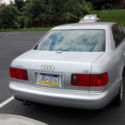 2000 audi a8l silver fully loaded needs tune up
2000 audi a8l silver fully loaded needs tune up
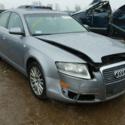 2007 Audi A6 AWD/Fully loaded/Leather Seats/No Reserve
2007 Audi A6 AWD/Fully loaded/Leather Seats/No Reserve
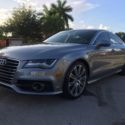 Silver 2012 Audi A7 Quattro Base Hatchback 4-Door 3.0L Prestige Fully Loaded
Silver 2012 Audi A7 Quattro Base Hatchback 4-Door 3.0L Prestige Fully Loaded
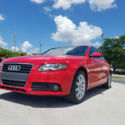 2012 Audi A4 Sedan 4-Door 2.0 TURBO ENGINE FULLY LOADED LOW MILES 41K NO RESERVE
2012 Audi A4 Sedan 4-Door 2.0 TURBO ENGINE FULLY LOADED LOW MILES 41K NO RESERVE
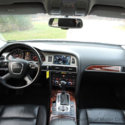 2007 Audi A6 4dr Sedan 3.2L quattro 161,537 Miles Light Silver Metallic Sedan 3.
2007 Audi A6 4dr Sedan 3.2L quattro 161,537 Miles Light Silver Metallic Sedan 3.
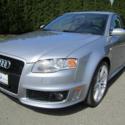 Avus Silver RS4 6 - Speed
Avus Silver RS4 6 - Speed
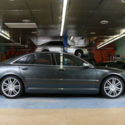 2007 Audi S8 Loaded, Fully Serviced, Sport Package, $8,000 below retail!!!
2007 Audi S8 Loaded, Fully Serviced, Sport Package, $8,000 below retail!!!
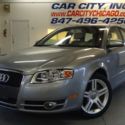 2007 AUDI A4 WAGON. PERFECT CONDITION. LOADED WITH LEATHER INTERIOR HEATED SEA
2007 AUDI A4 WAGON. PERFECT CONDITION. LOADED WITH LEATHER INTERIOR HEATED SEA
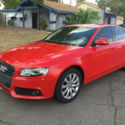 2009 Audi A4 Quattro Premium Plus Fully Loaded NO RESERVE
2009 Audi A4 Quattro Premium Plus Fully Loaded NO RESERVE
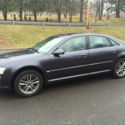 2005 AUDI A8 QUATRO AWD NAVIGATION FULLY LOADED NO RESERVE
2005 AUDI A8 QUATRO AWD NAVIGATION FULLY LOADED NO RESERVE
 2000 audi a8l silver fully loaded needs tune up
2000 audi a8l silver fully loaded needs tune up
Year: 2000
Mileage: 187,000
Mileage: 187,000
 2007 Audi A6 AWD/Fully loaded/Leather Seats/No Reserve
2007 Audi A6 AWD/Fully loaded/Leather Seats/No Reserve
Year: 2007
Mileage: 112,558
Mileage: 112,558
 Silver 2012 Audi A7 Quattro Base Hatchback 4-Door 3.0L Prestige Fully Loaded
Silver 2012 Audi A7 Quattro Base Hatchback 4-Door 3.0L Prestige Fully Loaded
Year: 2012
Mileage: 73,000
Mileage: 73,000
 2012 Audi A4 Sedan 4-Door 2.0 TURBO ENGINE FULLY LOADED LOW MILES 41K NO RESERVE
2012 Audi A4 Sedan 4-Door 2.0 TURBO ENGINE FULLY LOADED LOW MILES 41K NO RESERVE
Year: 2012
Mileage: 41,081
Mileage: 41,081
 2007 Audi A6 4dr Sedan 3.2L quattro 161,537 Miles Light Silver Metallic Sedan 3.
2007 Audi A6 4dr Sedan 3.2L quattro 161,537 Miles Light Silver Metallic Sedan 3.
Year: 2007
Mileage: 161,537
Mileage: 161,537
 Avus Silver RS4 6 - Speed
Avus Silver RS4 6 - Speed
Year: 2007
Mileage: 92,941
Mileage: 92,941
 2007 Audi S8 Loaded, Fully Serviced, Sport Package, $8,000 below retail!!!
2007 Audi S8 Loaded, Fully Serviced, Sport Package, $8,000 below retail!!!
Year: 2007
Mileage: 110,046
Mileage: 110,046
 2007 AUDI A4 WAGON. PERFECT CONDITION. LOADED WITH LEATHER INTERIOR HEATED SEA
2007 AUDI A4 WAGON. PERFECT CONDITION. LOADED WITH LEATHER INTERIOR HEATED SEA
Year: 2007
Mileage: 107,164
Mileage: 107,164
 2009 Audi A4 Quattro Premium Plus Fully Loaded NO RESERVE
2009 Audi A4 Quattro Premium Plus Fully Loaded NO RESERVE
Year: 2009
Mileage: 121,075
Mileage: 121,075
 2005 AUDI A8 QUATRO AWD NAVIGATION FULLY LOADED NO RESERVE
2005 AUDI A8 QUATRO AWD NAVIGATION FULLY LOADED NO RESERVE
Year: 2005
Mileage: 132,950
Mileage: 132,950
